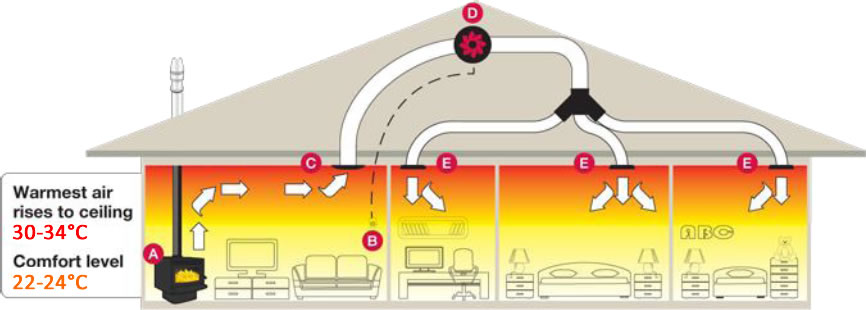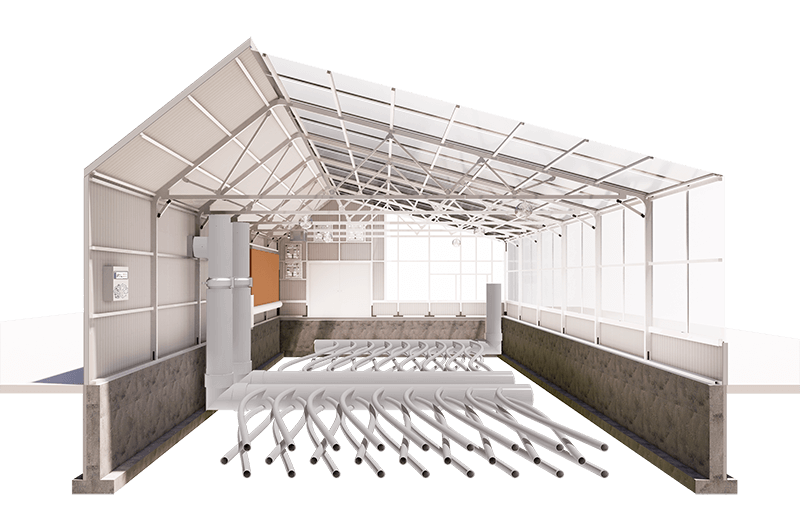A Comprehensive Guide to Choosing the Right Heat Transfer Solutions for Your Demands
Picking the proper Heat transfer system is necessary for functional effectiveness. Numerous systems cater to various needs, influenced by variables such as temperature variety and fluid kind. Recognizing the principles behind Heat transfer, such as convection, transmission, and radiation, is critical. Furthermore, examining energy sources and upkeep methods can affect lasting efficiency. A closer evaluation of these factors to consider reveals exactly how to customize a system to details demands. What should one prioritize in this facility decision-making procedure?
Understanding Heat Transfer: Secret Concepts and Principles
Heat transfer might appear like an uncomplicated concept, it incorporates an array of concepts that are essential for reliable system design - DVS Heat Transfer Systems. Recognizing these concepts is essential for developers and designers who aim to optimize thermal efficiency in different applications. Conduction, for circumstances, involves the transfer of Heat with strong products, while convection describes the movement of Heat within liquids. Radiation, an additional essential concept, explains exactly how Heat can be moved through electromagnetic waves. Each of these devices plays a vital duty in identifying how power moves within a system. By thoroughly understanding these principles, professionals can make educated choices, ensuring that Heat transfer systems run efficiently and satisfy the details demands of their applications
Types of Heat Transfer Equipments: An Introduction
Comprehending the principles of Heat transfer prepares for discovering the different types of Heat transfer systems available. Heat transfer systems can be classified largely into three kinds: conduction, radiation, and convection. Transmission involves Heat transfer through solid materials, counting on direct call in between particles. Convection, on the various other hand, occurs in liquids (fluids and gases) where the motion of the liquid itself assists in Heat transfer. Radiation includes the transfer of Heat with electro-magnetic waves and does not require a tool, enabling it to occur in a vacuum. Each sort of system has distinctive features and applications, making it important for individuals and organizations to thoroughly examine their specific demands when choosing one of the most suitable Heat transfer option.
Applications of Heat Transfer Solutions in Numerous Industries
Heat transfer systems play an essential duty throughout various industries, impacting efficiency and item quality. In industrial production procedures, they help with exact temperature level control, while in food and beverage processing, they guarantee security and conservation. In addition, HVAC and environment control systems depend heavily on reliable Heat transfer to maintain comfortable atmospheres.
Industrial Production Processes

Many commercial production procedures count greatly on efficient Heat transfer systems to make the most of performance and enhance product high quality. In fields such as metalworking, Heat exchangers play an important function in preserving excellent temperatures throughout welding, casting, and forging. These systems assure consistent Heat distribution, which is important for accomplishing wanted product properties. Likewise, in the chemical manufacturing market, Heat transfer systems help with accurate temperature level control during responses, affecting yield and safety. In addition, in textile manufacturing, efficient Heat monitoring is essential for dyeing and ending up procedures, affecting shade consistency and textile quality. By selecting ideal Heat transfer technologies, makers can boost power effectiveness and lower functional expenses, ultimately resulting in an extra lasting and competitive manufacturing environment.
Food and Drink Handling
Reliable Heat transfer systems are equally crucial in the food and drink handling market, where maintaining optimal temperatures is vital for food safety and security and quality. These systems play an important duty in procedures such as food preparation, pasteurization, and sterilization, making certain that products are safe for consumption and retain their dietary value. Heat exchangers, as an example, successfully move Heat between liquids, maximizing energy use while lessening temperature level variations. Additionally, refrigeration systems are basic for maintaining subject to spoiling things and extending rack life. The choice of Heat transfer technology straight influences operational efficiency and item stability, making it crucial for food and drink suppliers to pick the appropriate systems tailored to their specific handling requirements. This cautious selection ultimately contributes to consumer complete satisfaction and food safety.

Cooling And Heating and Climate Control
While numerous markets depend on Heat transfer systems for effectiveness, COOLING AND HEATING (Home Heating, Ventilation, and Cooling) plays an important function in maintaining interior environment control across numerous settings. These systems make use of Heat transfer principles to regulate temperature level, air, and humidity high quality, guaranteeing comfort and security in property, business, and click over here now commercial settings. Appropriately developed heating and cooling systems improve energy efficiency, decrease operational costs, and minimize environmental impact. In commercial buildings, for instance, reliable climate control contributes to staff member efficiency and customer contentment. In industrial applications, heating and cooling systems aid maintain excellent conditions for equipment procedure and product preservation. Choosing the best Heat transfer system is vital for conference particular environment control demands and achieving total system performance.
Assessing Power Resources for Heat Transfer Systems
In examining energy resources for Heat transfer systems, a contrast of renewable resource options and fossil gas factors to consider is necessary. Renewable resources, such as solar and wind, offer lasting choices that can decrease ecological effect. Alternatively, fossil fuels continue to be common because of their well established infrastructure and energy thickness, prompting a careful evaluation of both options.
Renewable Power Options

Fossil Gas Factors To Consider
Assessing fossil gas considerations is important for the efficiency and sustainability of Heat transfer systems. Nonrenewable fuel sources, such as natural gas, oil, and coal, are conventional energy sources that offer substantial Heat output, making them preferred choices for household and industrial applications. Nevertheless, their ecological influence, consisting of greenhouse gas exhausts and resource exhaustion, increases worries. When choosing a warmth transfer system, it is important to evaluate the availability, expense, and regulatory factors connected with these gas. Additionally, the performance of nonrenewable fuel source systems must be thought about, as greater efficiency can alleviate some ecological drawbacks. Ultimately, a well balanced approach weighing efficiency and sustainability can direct decision-makers towards the most ideal Heat transfer option for their details requirements.
Variables to Consider When Picking a Heat Transfer System
Choosing a suitable Heat transfer system requires mindful factor to consider of various elements that can substantially affect efficiency and efficiency. One essential variable is the operating temperature array, which dictates the materials and layout appropriate for the application. Additionally, the kind of liquid utilized in the system-- whether gas or fluid-- affects Heat transfer performance and compatibility. The system's size and ability should straighten with the certain demands of the operation to avoid inadequacies. Power source schedule is additionally essential, influencing operating costs and sustainability. Additionally, the setup setting, including area constraints and access for maintenance, plays a considerable duty in system option. Lastly, governing compliance and safety standards have to be taken into consideration to ensure the system fulfills all lawful requirements.
Maintenance and Effectiveness Optimization for Heat Transfer Equipments
Keeping Heat transfer systems is important for making sure optimal performance and durability. Regular upkeep activities, such as cleansing Heat exchangers and evaluating insulation, assistance avoid effectiveness losses as a result of fouling and thermal connecting. In addition, keeping an eye on system parameters, consisting of pressure and temperature level, allows for very early discovery of anomalies, lessening downtime and costly repairs. Applying a precautionary maintenance timetable can maximize performance and prolong the life expectancy of parts. Moreover, upgrading to sophisticated control systems can boost operational effectiveness by changing to differing lots and problems. By prioritizing upkeep and effectiveness optimization, operators can accomplish minimized energy consumption, lower functional prices, and improved overall system dependability, inevitably resulting in much better source use and an extra lasting procedure.
Future Trends in Heat Transfer Technologies
As markets significantly focus on sustainability and power performance, future fads in Heat transfer innovations are set to undertake significant improvements. Advancements such as advanced products, including carbon nanotubes and nanofluids, assure enhanced thermal conductivity and performance. In addition, the combination of renewable resource resources right into Heat transfer systems is acquiring momentum, advertising environmentally friendly services. Smart modern technologies, including IoT sensing units, are expected to revolutionize tracking and control, making it possible for real-time information analysis for maximized efficiency. Moreover, the advancement of portable and modular systems will this content certainly assist in easier installation and maintenance, accommodating diverse applications. These innovations show a shift in the direction of even more sustainable, reliable, and versatile Heat transfer options, aligning with worldwide power goals and environmental requirements.
Regularly Asked Questions
What Are the Ecological Impacts of Heat Transfer Solutions?
The ecological influences of Heat transfer systems can include greenhouse gas emissions, energy intake, and potential thermal pollution. Furthermore, improper disposal of inadequacies and products can add to why not try here resource deficiency and community disturbance.
How Do I Compute the Cost-Effectiveness of a Warm Transfer System?
To determine the cost-effectiveness of a heat transfer system, one have to analyze initial prices, operational costs, maintenance requirements, and energy performance, contrasting these elements against the expected life expectancy and efficiency of the system.
Can Heat Transfer Solution Be Used in Residential Settings?
Heat transfer systems can without a doubt be utilized in domestic settings. They provide reliable home heating and cooling options, making homes a lot more comfy while possibly decreasing power prices. Their convenience permits for various applications in household atmospheres.
What Safety And Security Rules Put On Heat Transfer Systems?
Safety regulations for Heat transfer systems typically include guidelines on upkeep, installment, and procedure. Compliance with neighborhood building ordinance, producer specs, and sector requirements is important to ensure secure and reliable system performance in various applications.
Just How Do Various Materials Affect Heat Transfer Performance?

Conduction, for circumstances, includes the transfer of Heat with solid products, while convection refers to the motion of Heat within fluids. Comprehending the concepts of Heat transfer lays the groundwork for exploring the various types of Heat transfer systems offered. Heat exchangers, for circumstances, effectively move Heat in between fluids, maximizing power use while lessening temperature level variations. In assessing power sources for Heat transfer systems, a contrast of renewable energy choices and fossil fuel factors to consider is essential. Steels, such as copper and light weight aluminum, conduct Heat properly, whereas insulators like rubber and glass slow down Heat flow.